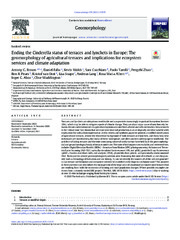Ending the Cinderella status of terraces and lynchets in Europe: The geomorphology of agricultural terraces and implications for ecosystem services and climate adaptation
Permanent lenke
https://hdl.handle.net/10037/21947Dato
2021-01-20Type
Journal articleTidsskriftartikkel
Peer reviewed
Forfatter
Brown, Antony; Fallu, Daniel Joseph; Walsh, Kevin; Cucchiaro, Sara; Tarolli, Paolo; Zhao, Pengzhi; Pears, Ben R.; Oost, Kristof; Snape, Lisa; Lang, Andreas; Albert, Rosa Maria; Alsos, Inger Greve; Waddington, CliveSammendrag
Terraces and lynchets are ubiquitous worldwide and can provide increasingly important Ecosystem Services (ESs), which may be able to mitigate aspects of climate change. They are also a major cause of non-linearity between climate and erosion rates in agricultural systems as noted from alluvial and colluvial studies. New research in the ‘critical zone’ has shown that we must now treat soil production as an ecologically sensitive variable with implications for soil carbon sequestration. In this review and synthesis paper we present a modified classification of agricultural terraces, review the theoretical background of both terraces and lynchets, and show how new techniques are transforming the study of these widespread and often ancient anthropogenic landforms. The problems of dating terraces and the time-consuming nature of costly surveys have held back the geomorphological and geoarchaeological study of terraces until now. The suite of techniques now available, and reviewed here, includes Digital Elevation Models (DEMs) - Structure from Motion (SfM) photogrammetry, Airborne and Terrestrial Laser Scanning (ALS-TLS); optically stimulated luminescence (OSL and pOSL), portable X-ray fluorescence (pXRF), Fourier-transform infra-red analysis (FTIR), phytoliths from plants, and potentially environmental DNA. Three process-related geomorphological questions arise from using this suite of methods; a) can they provide both a chronology of formation and use history, b) can we identify the sources of all the soil components? c) Can terrace soil formation and ecosystem services be modelled at the slope to catchment scale? The answers to these questions can also inform the management of the large areas of abandoned and under-used terraces that are resulting from both the economics of farming and rural population changes. Where possible, examples are drawn from a recently started ERC project (TerrACE; ERC-2018-2023; https://www.terrace.no/) that is working at over 15 sites in Europe ranging from Norway to Greece.
Forlag
ElsevierSitering
Brown A, Fallu DJ, Walsh K, Cucchiaro S, Tarolli P, Zhao P, Pears BR, Oost, Snape L, Lang A, Albert RM, Alsos IGA, Waddington C. Ending the Cinderella status of terraces and lynchets in Europe: The geomorphology of agricultural terraces and implications for ecosystem services and climate adaptation. Geomorphology. 2021;379Metadata
Vis full innførselSamlinger
Copyright 2021 The Author(s)


 English
English norsk
norsk